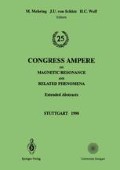Abstract
The ESR lineshape of one electron spin coupled by anisotropic hyperfine interaction to a number of nuclei is calculated when at least two different configurations of the molecule interchange according to a given reaction scheme. The spectrum calculation includes also the anisotropic electron- zeeman and the nuclear quadrupole interaction. The lineshape, which simulates a nonsaturated CW experiment, is calculated numerically by a direct method and includes the nonsecular terms of the electron spin. The density matrix theory, combined with Liouville formalism, is used allowing both for an accurate treatment of spin dynamics as well as detailed description of the reorganization of the system during exchange [1]. The exchange is treated phenomenologically by a sudden-jump, markov model in which the steady-state populations are calculated prior to the lineshape and are used for the lineshape calculation. For a given overall molecular orientation each configuration (site) is characterized by a set of three strength constants and three Euler angles per interaction [2]. This basic system is used to simulate a single crystal case or is appropriately averaged to simulate a powder sample. The above theory is compared with two experiments.
SYSTEM (1): We model the rotation of the CH2 group around the C-C bond in the radical CH2COO-. Zn(acetate)2 crystals were grown from a water solution and were irradiated by X-rays. The spectra were produced with an X band ESR spectrometer for a couple of orientation of the crystal.
SYSTEM (11): A three-site model was incorporated to model the ring dynamics of C4H9N+. The cations were isolated by irradiation in inert halogenide matrix by standard methods [3] at low temperature. The ring was studied lately in a quantum chemical calculation [3].
Access this chapter
Tax calculation will be finalised at checkout
Purchases are for personal use only
References
Nonperturbative ESR Lineshapes of an Isotropic Three-Site System and Comparison with Experimental CH3-COOD and CD3-COOD Spectra. U. Nord, N.P. Benetis, N.A. Salih and A. Lund Manuscript.
The Use and Transformations of Second-Order Tensors in Magnetic Resonance. N.P. Benetis and A. Lund Manuscript.
An ESR Theoretical Ab Initio UHF/CI Investigation of the Structure and Dynamics of the Pyrrolidine Radical Cation of a Neutral Pyrrolidine Radical M. Shiotani, L. Sjöqvist, A. Lund, S. Lunell, L. Eriksson and M.B. Huang Submitted
Author information
Authors and Affiliations
Editor information
Editors and Affiliations
Rights and permissions
Copyright information
© 1990 Springer-Verlag Berlin Heidelberg
About this paper
Cite this paper
Benetis, N.P., Erickson, R., Sjöqvist, L., Lund, A., Maruani, J. (1990). ESR Lineshape for Exchanging Anisotropic Spin Systems. In: Mehring, M., von Schütz, J.U., Wolf, H.C. (eds) 25th Congress Ampere on Magnetic Resonance and Related Phenomena. Springer, Berlin, Heidelberg. https://doi.org/10.1007/978-3-642-76072-3_65
Download citation
DOI: https://doi.org/10.1007/978-3-642-76072-3_65
Publisher Name: Springer, Berlin, Heidelberg
Print ISBN: 978-3-540-53136-4
Online ISBN: 978-3-642-76072-3
eBook Packages: Springer Book Archive

